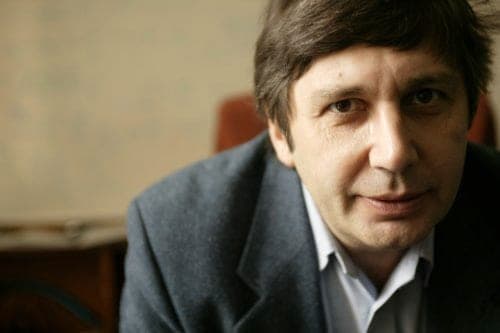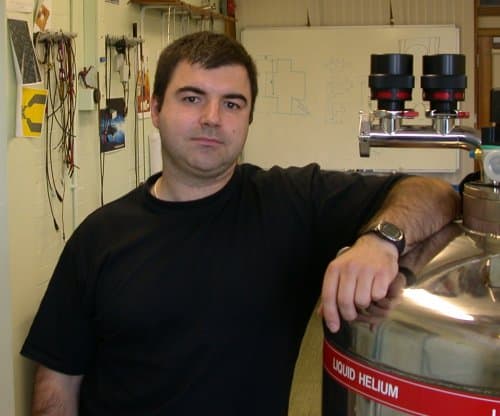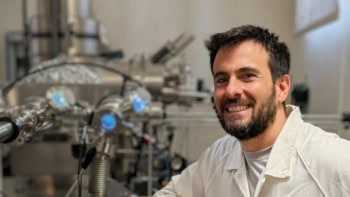
The 2010 Nobel Prize in Physics has been awarded jointly to Andre Geim and Konstantin Novoselov “for groundbreaking experiments regarding the two-dimensional material graphene”.
Both physicists work at the University of Manchester in the UK.
In a telephone interview with Swedish journalists minutes after the announcement, Geim said that he was answering e-mails when he found out about the award. “When I got the call, I thought ‘oh shit’, because it is a life-changing exercise.”
Graphene is a sheet of crystalline carbon just one atom thick. Many physicists believed that a 2D crystal like graphene would always roll up rather than stand free in a planar form, but in 2004 Geim and Novoselov brought to an end years of unsuccessful attempts to isolate graphene, and were able to visualize the new crystal using a simple optical microscope.
The material is very strong and an excellent conductor of heat and electricity. As such it is often described as a “wonder material” with many possible technological applications from ultra-fast transistors to DNA sequencing. When asked what is his dream application for graphene Geim replied, “That’s a difficult question…I don’t want to pick out any particular applications, there are so many.”
Ahead on intuition
“[Novoselov and Geim] really deserve the prize,” said Andrea Ferrari of Cambridge University, who started working on graphene shortly after its discovery. “They are way above other people in terms of their intuition and they have done key work in all the main subfields – looking at graphene’s electronic, mechanical and other properties.”
Ferrari also told physicsworld.com that the two physicists were very generous about sharing their discovery with other scientists. “From day one they were completely open about how to make graphene,” he said. “They trained the first generation of physicists in how to make graphene by inviting scientists to Manchester.”
The two researchers discovered the material by using a piece of adhesive tape to peel a single atomic layer off a piece of graphite – a process known as micromechanical cleavage or the “Scotch tape method”.
The pair then worked out how to make field-effect transistors using the material and discovered that electrons in the device were able to travel ballistically – that is, without being scattered – from the source to the drain electrode at room temperature.
As famous as silicon
In principle, ballistic transistors could operate much faster than conventional devices made of silicon and this discovery led to a flurry of research into the electronic properties of graphene that shows no signs of abating.
In 2005 Geim and Novoselov showed that the electrons in graphene behave like relativistic particles called “Dirac fermions” that have no rest mass. The pair also observed a new “half-integer” quantum Hall effect in the material.
More recently, Geim and Novoselov have shown that graphene has the ideal optical properties to form the transparent electrodes in liquid-crystal displays (LCDs); fabricated tiny quantum dots from graphene; and developed a new way of manufacturing sizable quantities of graphene. Just last year the pair created a new material called graphane by adding hydrogen atoms to their original discovery.
Surge of interest
The discovery of graphene triggered a surge of interest in the wonder material. Other researchers, for example, have found that graphene not only conducts heat very well but is also the “strongest material in the world”.
At a practical level, one team of scientists has created a new kind of chemical sensor by combining graphene with DNA, while another group used the material to gain a better understanding of surface-enhanced spectroscopy.
Novoselov was born in the Soviet Union in 1974 and did a PhD at the University of Nijmegen in the Netherlands before joining the University of Manchester in 2001, where he is Leverhulme Research Fellow. He is a British and Russian citizen.
Born in the Soviet Union in 1958, Geim did a PhD at the Institute of Solid State Physics in Chernogolovka, Russia. He was associate professor at the University of Nijmegen in the Netherlands before joining the University of Manchester in 2001, where he is director of the Centre for Mesoscience and Nanotechnology. He is a Dutch citizen.
‘We’ve struck gold’
Speaking to physicsworld.com in 2006 Geim said, “In the different areas that I’ve worked in for the last 20 years I’ve been searching for something big. I think with graphene at last I’ve found it. Before I relied on professionalism or hard work but never had the luck. Now at last I think I’ve been lucky and that we’ve struck gold.”
Geim is also famous for his 1997 “flying frog” experiment in which he and his colleagues in Nijmegen levitated a frog using a powerful magnet. He shared the 2000 “IgNobel” prize (with Michael Berry of the University of Bristol) for his efforts and is the first individual to win both awards.
Berry told physicsworld.com, “I’m delighted that my fellow IgNobelist has been Stockholmed. I knew it was only a matter of time, and it’s good they didn’t make him wait decades. Knowing him, it won’t spoil his scientific creativity – he has a great deal of science left in him.”
The prize is the second in as many days for UK-based scientists and comes at a time when British science is under threat from funding cuts. Marshall Stoneham, president of the UK’s Institute of Physics said that the physics prize shows the “strength of the British science base. It confirms at the highest level the excellence of UK physics”.
The Nobel prize is worth SEK10m and will be presented at a ceremony in Stockholm on 10 December.
Further information
Download three feature articles about Geim, Novoselov and their work on graphene here:
“Beyond the wonder material” by Konstantin Novoselov (PDF, 1 MB)
The Nobel winner describes the amazing properties of graphene’s chemical cousin graphane
“A physicist of many talents” (PDF, 140 KB)
Andre Geim talks to Physics World about his wide-ranging career
“Drawing conclusions from graphene” (PDF, 1.6 MB)
Antonio Castro Neto, Francisco Guinea and Nuno Miguel Peres explore the fascinating structure of graphene
Watch a lecture by Geim on graphene
“Graphene — exploring carbon flatland”
Andre Geim gives a video lecture on the importance of graphene at the 2008 Condensed Matter and Materials Physics conference of the Institute of Physics




